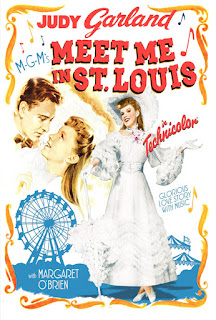December 22nd: MEET ME IN ST. LOUIS (Vincente Minnelli, 1944)
In the lead-up to the 1904 World's Fair in St. Louis, a family with four daughters experiences love and loss and the possibility of being uprooted to New York City.
Arthur Freed worked vaudeville in the early 1900s, on stage and as a songwriter, and was hired by Metro-Goldwyn-Mayer to work on songs for musicals. An associate producer's role on The Wizard of Oz led to him being put in charge of a new musical unit at the studio (a post he would hold for over 30 years). Freed acquired an impressive roster of talent in front of and behind the camera, giving many of them an unprecedented level of creative control.
After a string of modest successes, Freed decided to make a film where the songs would thematically connect to the story and characters, unusual up to that time. He commissioned a script based on the semi-autobiographical stories of Sally Benson, whose work was recently serialized in The New Yorker, requesting the specific structure of the life of a family over the course of a single year. To direct, Freed hired Vincente Minnelli, a former stage director and set and costume designer who had only two films under his belt.
The cast was headed by former child star Judy Garland, at 21 years-old already a veteran with MGM. Initially uninterested in the project at the fear of being further typecast as "The Girl Next Door", she agreed due to her professional relationship with Freed. Also cast was Mary Astor (The Maltese Falcon), the 7 year-old Margaret O'Brien, perennial father figure Leon Ames, Marjorie Main, June Lockhart (TV's Lost In Space), and Harry Davenport (Gone With The Wind).
The film was shot in Technicolor by George J. Folsety on the studio lot, a whole street of houses built for the production (and used for decades afterwards). Minnelli's attention to detail included having Benson describe the interior of her childhood home in detail, and the designs for many costumes were taken straight out of department store catalogues from the time period.
Garland proved difficult on the set with attendance issues and an apparent lack of motivation. She soon forged a bond with Minnelli as he encouraged the make-up department to give her the glamour makeover the studio resisted letting her have. The two would fall in love during the production and marry soon after, the effect apparent in the way Garland is photographed as well as her depth of feeling on-screen.
The songs featured in the film are a combination of selections from the time period, as well as ones written specifically for the production, including one co-penned by Freed himself. In addition to the now-classic "Have Yourself A Merry Little Christmas", standouts include "The Trolley Song", "The Boy Next Door", and "You And I".
The film was released to overwhelming critical and box office success, and was the second-highest-grossing film of the year. Its photography is considered one of the early standout examples of Technicolor, and was nominated for an Academy Award, along with the musical score, "The Trolley Song", and the screenplay. O'Brien received an honorary Juvenile Award. Freed considered it his favorite out of all his productions.
Running time is approx. 110 minutes.











Comments
Post a Comment